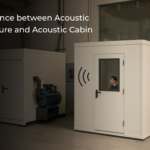Noise pollution is one of the most pervasive and under-recognized environmental issues in India. With rapid urbanization and industrial growth, the constant hum of machinery, generators, and industrial processes has created a cacophony that threatens public health, productivity, and ecological balance. Against this backdrop, acoustic enclosures are emerging as a critical solution, offering innovative ways to control noise pollution and promote quieter environments.
Understanding Acoustic Enclosures
Acoustic enclosures are specially designed structures or coverings that surround noise-generating equipment to absorb and reduce sound emissions. Constructed using soundproof materials, these enclosures are engineered to minimize noise without hindering the functionality of the equipment.
Key Features of Acoustic Enclosures :
- Material Composition : They are often made from high-density panels, composite walls, and noise-dampening foam.
- Customizable Design : Enclosures can be tailored to fit various machinery, from industrial generators to HVAC systems.
- Functionality : Many designs ensure ventilation and heat dissipation, crucial for maintaining equipment efficiency.
The Need for Acoustic Enclosures in India
India’s burgeoning industrial and urban growth has made noise pollution a pressing concern. According to the Central Pollution Control Board (CPCB), many industrial and urban areas in India consistently exceed the permissible noise limits, set at 75 decibels for industrial zones during the day and 55 decibels for residential areas.
Health Impacts of Noise Pollution
- Human Health : Prolonged exposure to high noise levels can lead to hearing loss, cardiovascular stress, sleep disturbances, and reduced productivity.
- Workplace Safety : In industrial settings, excessive noise can impair communication and increase the risk of accidents.
Regulatory Push
India’s Noise Pollution (Regulation and Control) Rules, 2000, mandate noise control measures in industrial and urban settings. Acoustic enclosures have become essential for compliance, particularly in industries operating heavy machinery or power generators.
Applications of Acoustic Enclosures
- Industrial Machinery : Enclosures are widely used in factories to surround equipment like compressors, turbines, and crushers.
- Power Generators : Diesel generators, common in India due to frequent power outages, are major noise sources. Acoustic enclosures ensure compliance with CPCB noise standards.
- HVAC Systems : Heating, ventilation, and air conditioning units in commercial buildings often incorporate noise-reduction enclosures to improve indoor comfort.
- Construction Sites : Portable acoustic barriers are increasingly used to reduce noise from drilling, excavation, and other construction activities.
Technological Advancements in Acoustic Enclosures
The rise of acoustic enclosures in India is driven by technological innovations that make them more effective and adaptable:
- Advanced Materials : Modern enclosures use lightweight, high-density materials that combine sound absorption with thermal resistance.
- Modular Designs : Prefabricated modular enclosures allow for easier installation and scalability.
- Green Acoustic Solutions : Some manufacturers are developing eco-friendly enclosures using recyclable and sustainable materials.
Market Trends in India
The demand for acoustic enclosures is growing in India, with applications spanning industries, infrastructure projects, and urban development. Key factors influencing this trend include:
- Stringent Regulations : Increased enforcement of noise control standards by the CPCB and local authorities.
- Urban Expansion : As cities expand, noise-sensitive zones like hospitals and schools require enhanced noise management solutions.
- Industrial Automation : Automation and the use of high-capacity machinery in manufacturing necessitate effective noise control.
Challenges in Adoption
Despite their benefits, the adoption of acoustic enclosures in India faces challenges:
- Cost Constraints : High initial investment deters smaller businesses from implementing enclosures.
- Awareness Gap : Limited understanding of noise pollution’s impact and the benefits of enclosures reduces demand.
- Maintenance : Poor maintenance can diminish the effectiveness of acoustic enclosures over time.
According to available information, several Indian companies have installed acoustic enclosures, including Reliance Industries Limited, Adani group of Industries, BARC, Asian Paints, HP, Godrej, NPCIL, Mahindra and other industrial facilities across sectors like power generation, manufacturing, and automotive; companies like Thermosonics Pvt. Ltd often provide acoustic enclosure solutions to these clients in India
The Future of Acoustic Enclosures in India
As awareness about noise pollution grows, acoustic enclosures are set to play an even greater role in India’s sustainable development. Future advancements may include:
- Increased Automation : Smart acoustic solutions will integrate with broader environmental monitoring systems.
- Government Incentives : Policies to subsidize noise control measures for industries could accelerate adoption.
- Wider Applications : Beyond industries, enclosures may find use in residential and community settings, such as soundproofing urban highways and public spaces.
Conclusion
Acoustic enclosures symbolize a silent revolution in India’s fight against noise pollution. By addressing industrial and urban noise challenges, they not only enhance environmental and workplace safety but also contribute to a better quality of life for millions.
As India continues its path toward industrialization and urbanization, unlocking the power of silence through innovative solutions like acoustic enclosures will be key to creating harmonious and sustainable spaces.






